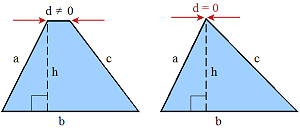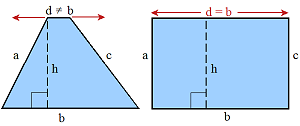Let's tackle the case of a triangle, where one only needs to envision shortening one of the trapezoid's parallel sides down to a single point. For the sake of convenience let us imagine that the side being shrunk is the side labeled "d" (i.e., the top-side) as shown in the illustration below...

| P = | a + b + c + 0 | & | A = | 0.5(b + 0) × h |
| = | a + b + c | = | 0.5(b) × h | |
| = | 0.5bh | |||
| or | bh ÷ 2 | |||
|
there you are [french phrase] |
|---|
|
a notable achievement; an amazing accomplishment |
|---|
In the instance of a rectangle, the trapezoid needs to transform where both parallel sides are equal in length and coincide with each other in horizontal position. Once more for convenience's sake we choose to alter the side labeled "d" (top-side in the illustration) allowing it to stretch until

Where does this leave us? We can utilize the equivalences "a = c" and "b = d," in both of the trapezoid formulas as follows:
| P = | a + b + a + b | & | A = | 0.5(b + b) × h |
| = | 2a + 2b | = | 0.5(2b) × h | |
| = | 2h + 2b | = | 1b × h | |
| = | 2b + 2h | = | bh |